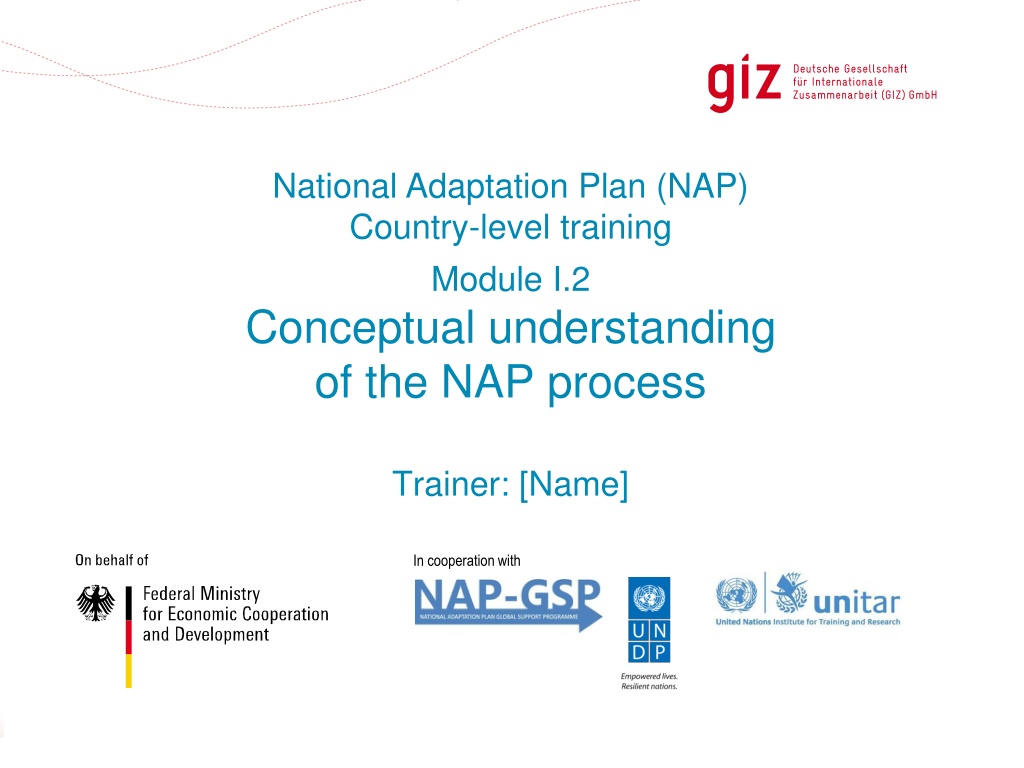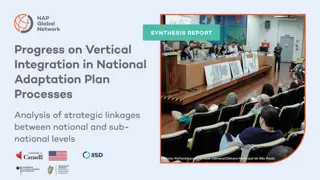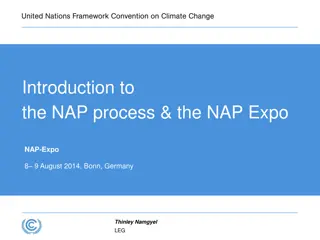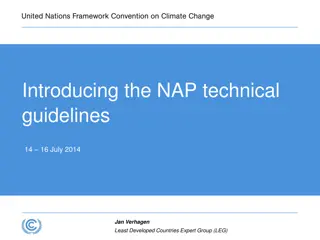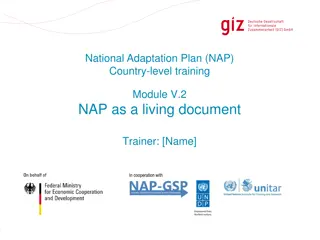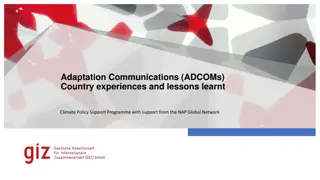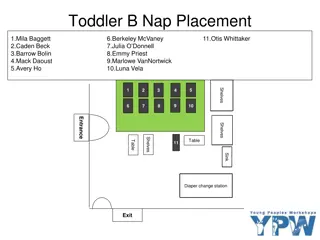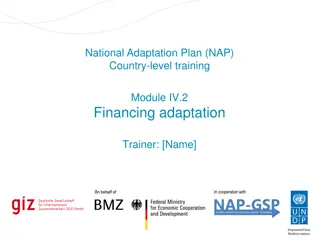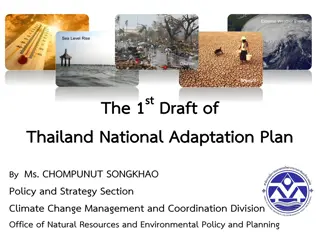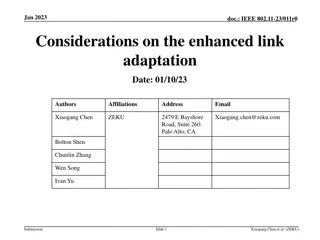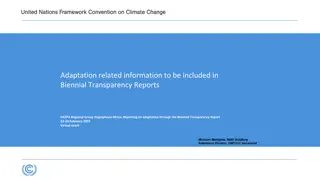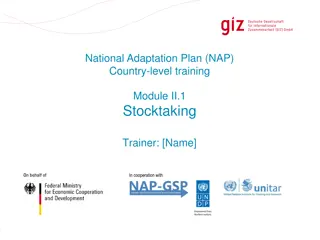Understanding the National Adaptation Plan (NAP) Process
Explore the conceptual understanding of the NAP process, highlighting its characteristics, importance for countries, and relation to other national processes. Learn about the objectives of NAP, its flexible and integrated nature, and the focus on reducing vulnerability and mainstreaming climate adaptation. Discover support channels, engagement progress, and the iterative, transparent, and gender-sensitive approach to managing climate risks.
Download Presentation

Please find below an Image/Link to download the presentation.
The content on the website is provided AS IS for your information and personal use only. It may not be sold, licensed, or shared on other websites without obtaining consent from the author. Download presentation by click this link. If you encounter any issues during the download, it is possible that the publisher has removed the file from their server.
E N D
Presentation Transcript
National Adaptation Plan (NAP) Country-level training Module I.2 Conceptual understanding of the NAP process Trainer: [Name] In cooperation with Slide 1
Overview of this module Adaptation under the UNFCCC Characteristics of the NAP process Importance of NAP for countries Relation of NAP to other processes Support channels for NAP Slide 2
What can you expect to learn from this session? Familiarize with the general concept and character of the NAP process Reflect on the relation to other national processes Get a first overview about existing support channels for NAP Slide 3
Focus of adaptation under the UNFCCC over time Further progress during COP 17-20: NAP Technical Guidelines Increased multilateral/ bilateral engagement Slide 4
Introduction to the NAP process Objectives of NAP Reduce vulnerability Integrate (= mainstream) climate change adaptation into new and existing development planning processes, within all relevant sectors and levels UNFCCC, 5/CP.17 Slide 5
Characteristics of the NAP process - I Flexible Non-prescriptive Countries select steps and approaches Country-owned, country-driven Driven by national needs and priorities National coordinating mechanism and mandate Slide 6
Characteristics of the NAP process - II Integrated Mainstream adaptation into development planning and budgets Iterative, building on existing efforts, improving coordination Transparent, participatory, gender-sensitive Improved climate risk management Define pipeline of interventions Align funding from all sources Learning, monitoring and evaluation Learn how to manage multiple climate risks through rigorous monitoring and review Slide 7
Importance of NAP for country processes Links adaptation priorities to development needs Sets clear objectives and priorities Supports mainstreaming Strengthens long term perspective Builds on existing work and helps synthesise and simplify Defines a pipeline of interventions Captures resources: public, private, national, international Supports coordination of adaptation efforts Specifies needs: knowledge, capacity, institutional, funding Sets out how progress will be measured and reported Slide 8
Besides NAP: What other relevant planning processes exist in your country? Who of you was involved in them already? Slide 9
NAP in the context of other relevant processes Outreach NAP National Growth Strategy Multi- sectoral SDG LEDS Green Growth Strategy HFA NAPA REDD+ Sectoral strategies NAMA Sectoral Planning horizon Short-term Long-term Slide 10
Institutions and support channels for NAP UNFCCC LEG Dev. Partners Funding sources Initial Guidelines (5/CP 17) Technical Guidelines, supplementary material, trainings, advisory, NAP Central Supplementary material, trainings, advisory Public, private, national, international resources Further information: www.unfccc.int/nap Slide 11
Exercise: Opportunities and challenges of the NAP process in your country You are invited to reflect the concrete situation of development and adaptation processes in your country Please delineate which opportunities and which challenges you expect from the NAP process in respect to the five principles Also consider concrete approaches you see for making use of opportunities and coping with challenges You will work in sub-groups defined by the moderator. Don t forget to document your findings (document your findings on a flipchart when you have an open discussion or in Matrix I.2.1 when you discuss structured according to the given questions) Slide 12
Imprint Published by Deutsche Gesellschaft f r Internationale Zusammenarbeit (GIZ) GmbH This presentation is part of a NAP country-level training that has been developed by GIZ on behalf of BMZ and in cooperation with the NAP Global Support Programme (NAP-GSP), in particular UNDP and UNITAR. Climate Policy Support Project Dag-Hammarskj ld-Weg 1-5 65760 Eschborn, Germany T +49 61 96 79-0 F +49 61 96 79-1115 The training is designed to support countries in setting up a National Adaptation Plan (NAP) process. It builds on the NAP Technical Guidelines developed by the Least- Developed Countries Expert Group (LEG). Contact E climate@giz.de I www.giz.de/climate You are welcome to use the slides, as long as you do not alter its content or design (including the logos), nor this imprint. If you have any questions regarding the training, please contact Till Below or Nele B nner at GIZ. For questions related to the Technical Guidelines, please refer to the UNFCCC s NAP Support Portal. Responsible Nele B nner, GIZ Authors Till Below Picture credits Title: Focus of adaptation (UNFCCC 2013), Institutions and support channels for NAP (UNFCCC 2011, LEG 2012, GIZ 2014, GCF 2014) As a federally owned enterprise, the Deutsche Gesellschaft f r Internationale Zusammenarbeit (GIZ) GmbH supports the German Government in achieving its objectives in the field of international cooperation for sustainable development. GIZ also engages in human resource development, advanced training and dialogue. Slide 13
